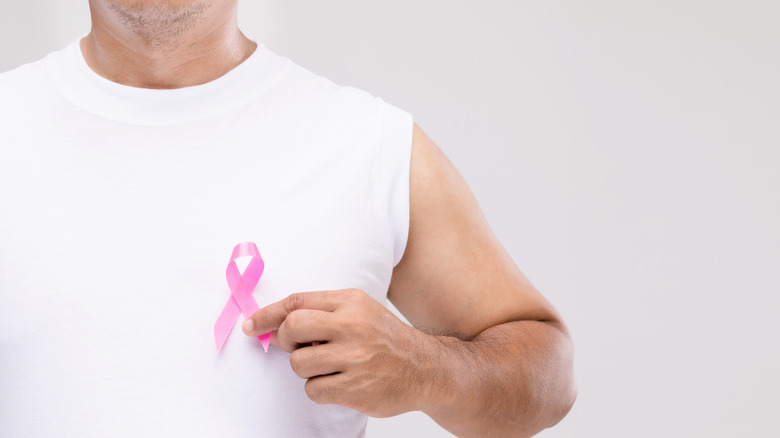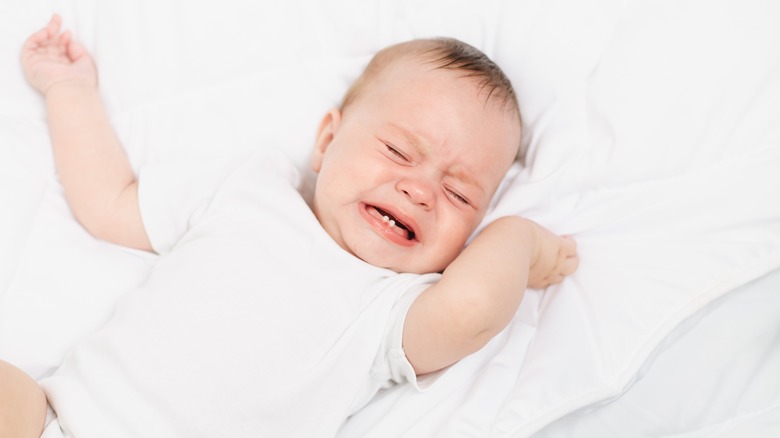What Causes Nipple Discharge In Males?
Both women and men have nipples, and you may be surprised to learn that both genders can experience nipple discharge. While fluid from the nipple is generally associated with women, particularly when it comes to breastmilk and breastfeeding babies, men can also experience nipple discharge for a variety of reasons, per Healthline. You may also be surprised to learn that male nipples have the same type of tissue as female nipples, as well as the same ducts for releasing breast milk. However, the reason we don't see men breastfeeding babies is because the hormones boys experience during puberty transform the breast tissue into fat, thus voiding the ability to produce enough milk to breastfeed, though sometimes men can experience a trickle of milk if their breast tissue maintains enough of the nipple milk duct to allow fluid to be released.
Sometimes male nipples may produce discharge spontaneously, which is most likely a sign of a more serious underlying condition. Nipple discharge doesn't necessarily come pouring out in the way you might envision when you think of milk or nipple ducts producing fluid. At times, nipple discharge may occur solely when the nipple is pinched or squeezed to push the discharge out. Other times, a man might notice enough discharge to leak through his shirt. The underlying cause of nipple discharge determines what kind of fluid emanates and how much leakage occurs, according to Medical News Today. Here's what you should know about male nipple discharge.
Puberty can be extra awkward
In case puberty wasn't awkward enough, some adolescents experience milky discharge from their nipples during this time of immense hormonal change (via Imaginis). This fact about puberty isn't well known, but it can affect both boys and girls. Particularly if the nipples are stimulated often, pinched, or breasts are handled in ways that place pressure on the nipples, the likelihood of pushing out milky or fluid discharge increases, says Healthline. Since hormones level out as puberty comes to an end, the presence of discharge should subside in both boys and girls. If post-pubescent boys or men experience nipple discharge, then it's advised to consult with a healthcare provider since adulthood nipple discharge in males is often a sign of something more complex and severe.
Some boys going through puberty may experience another condition called gynecomastia, in which the same breast tissue boys have at birth becomes enlarged, and the presence of enlarged breasts occurs, per WebMD. Just like how nipple discharge in pubescent boys is most frequently caused by changes in hormones, an imbalance in the same hormones can lead to enlarged tissue around the nipples and breasts. Should enlarged breasts be due to deposits of fat instead of hormones, then the condition is referred to as pseudogynecomastia. Boys who experience enlarged breast tissue or nipple discharge may be at risk of being bullied, so prioritize mental health and a supportive network of family and friends during this time.
Signs of male breast cancer
Breast cancer awareness is mostly associated with pink ribbons, usually representing women's breast cancer support. However, men can also develop breast cancer, and discharge from the nipples can be a sign of a malignant underlying cause, according to Healthline. If a man develops breast cancer, he may notice a discharge from his nipples that can range in color from clear fluid to beige or brown pus to bloody leakage or any combination of the various types. Should breast cancer be the underlying reason for nipple discharge, a man will often experience discharge from only one of his nipples, though it's also possible for both nipples to produce discharge.
Other symptoms of male breast cancer that relate to the nipples include the presence of inverted nipples, which is when a nipple goes from protruding to sinking into the breast and forming the shape of a crater, and a possible tiny bump that is hard in texture and can be felt around the nipple or elsewhere under the breast tissue. Lymph nodes that become swollen in the armpits are an additional sign of male breast cancer. If you notice any of these signs or symptoms of breast cancer, seek medical care as soon as possible.
Witch's milk and galactorrhea
There are a handful of reasons why boys and men may experience nipple discharge, including male infants who experience extra estrogen from their mothers and produce small amounts of milky discharge shortly after birth, a condition called neonatal galactorrhea (via Healthline). This condition is colloquially called "witch's milk" because of the original unknown cause during the 17th century and the stigma around newborns expressing milky discharge, but it should be noted that such stigma has been significantly lessened with the findings of modern medicine. Like other causes of childhood and adolescent nipple discharge, both male and female newborns can produce neonatal galactorrhea, which usually resolves on its own as the levels of the mother's estrogen lessen in the infant's body. Should the condition not resolve or if your baby is expressing discharge from only one nipple, schedule an appointment with your child's pediatrician for a thorough examination.
When discharge, particularly milky discharge, is produced from nipples and it isn't due to breastfeeding, such as nipple discharge in adolescent boys and adult men, then the condition is termed galactorrhea, according to Mayo Clinic. Unlike neonatal galactorrhea, adult galactorrhea can be caused by overstimulation of nipples, particularly sexual stimulation, abnormal activity of the pituitary gland, and as a side effect of some medications. Galactorrhea in males can be accompanied by sudden difficulty with vision and headaches, in addition to the hallmark symptom of milky discharge from one or both nipples.




